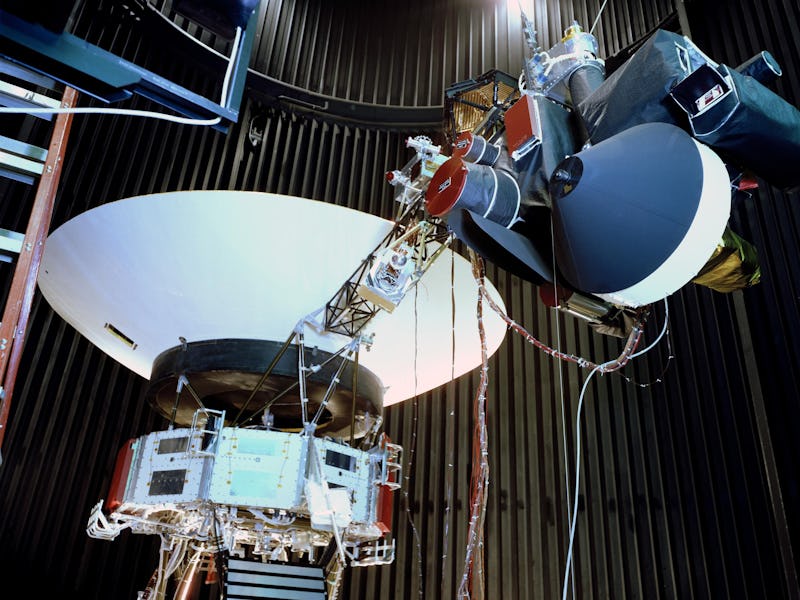After all these years, Voyager 2 is still teaching us new things
Never underestimate an old satellite or good research.

It seems like small potatoes now, but in 2004 the stakes couldn't be higher for Facebook. It was the website's first year out in the open, with Mark Zuckerberg's baby leaving its Harvard nest in March. The social media network started its takeover of the world cautiously, at first only expanding to a few other schools in the Boston area and of noticeable standing, like Stanford. Zuckerberg didn't want to take on reigning social media giant MySpace in one fell swoop, preferring to let it build around the site naturally.
But even in this limited capacity, the company was catching on. On December 30, 2004, Facebook registered its 1 millionth member. As a company that has over a billion members now, and has been cited as a threat to democracy, it's hard to remember that the site was once the coolest thing to hit the web. Everyone gets old.
As the year ends, we're expanding our question of the week to the rest of December. In one sentence, what's your prediction for 2021? Shoot us an email at newsletter@inverse.com. We'll be publishing our favorites at the beginning of the new year.
This is an adapted version of the Inverse Daily newsletter for December 30, 2020. Subscribe for free and earn rewards for reading every day in your inbox.
Ryugu revealed! — Japan release stunning first images of asteroid Ryugu samples
On December 6, a piece of an asteroid was found in the middle of the Australian desert.
But this wasn't an act of nature. It was a well-choreographed, meticulous transaction that took years of planning and execution.
Japan's Hayabusa2 spacecraft, which traveled for nearly six years in space to tag and collect a sample from asteroid Ryugu, dropped off a small capsule containing pieces of the space rock for analysis here on Earth. The Japan Aerospace Exploration Agency (JAXA) opened up the capsule last week, revealing the precious space cargo to the world for the first time. And there was a surprise in store.
More like this:
Pst pst pst — The science behind catnip’s potent powers, explained
Catnip has such an intoxicating effect on felines, it might as well be a drug — even though it technically isn't. For a long time, we haven't properly understood why cats are so drawn to catnip, also known as catmint (Nepeta cataria). But whether it makes your cat seemingly bombed, go haywire, or just fully pass out, every cat owner knows this herb can have some serious effects on our feline companions, altering their behavior and personalities.
A study published earlier this year in Science Advances finally provides an answer as to why catnip has such powerful effects. The plant's powers are thanks to an evolutionary trick that puts cats into a tizzy whenever they sniff this innocent-looking form of mint.
More like this:
Fossil finds — An ancient case of mistaken identity reveals a strange amphibian
Conducting scientific research can often feel like taking part in a detective mystery. You spent so much time hunting for evidence, dodging red herrings, and devising theories, only to realize that your deductions were wrong.
Then, suddenly, a new clue manifests as if out of thin air, leading you down a new long and winding road to discover the true culprit at the heart of your scientific mystery.
That's exactly what happened earlier this year when a team of scientific researchers found themselves investigating an ancient case of mistaken identity — one which led to a surprising amphibian culprit.
More like this:
Coming soon ...
You've been buying things over the holiday season, right? The chances that you're answering "yes" are less likely than it has been in years. With Covid-19 rattling the economy, businesses are still waiting to see what consumers will be doing in the future.
Coming soon on Inverse, a new paper looks at the 17 (yes, 17) buying trends that consumers tend to use when making a purchase. It might help you understand why your shopping cart is always filled.
New look — 30 years later, Voyager reveals new details about one of the Solar System's strangest planets
On January 24, 1986, Voyager 2 flew by the seventh planet from the Sun: Uranus.
The spacecraft beamed down thousands of images along with a host of scientific data and measurements of the planet, its atmosphere, and magnetic environment.
At the time, the data collected offered scientists an unprecedented look at the ice giant of our Solar System, revealing two new rings and 11 new moons, as well as chilling temperatures that dip below minus 353 degrees Fahrenheit.
This year, a team of scientists took a new look at the data collected from Voyager’s Uranus flyby and discovered the spacecraft had actually flown right through a plasmoid — a giant structure of a planet’s magnetic field, one which can strip a planet of its atmosphere.
Voyager 2 is still amazing scientists →
More like this:
- When Voyager glitched 11.5 billion miles from Earth, NASA had a plan
- Voyager 2 reveals new details about interstellar space
That's it for the Daily. If you're looking for more, check out our recommendations for the actors who stole scenes in 2020 like it was nobody's business.
Thank you for reading! Follow me on Twitter if you want, where I tweet too much.
And since this is my last Daily of the year, I'll also say: thank you so much for reading Inverse Daily in 2020. There's a whole team behind me that makes sure this newsletter gets out just so, and between all of us, there's a real pride in making sure you're getting the best possible Inverse Daily we can make. There's no shortage of content out there, so thank you for making us even just a small part of your day in 2020. See you next year!